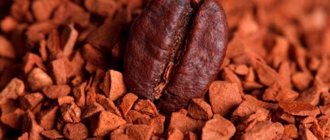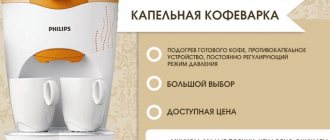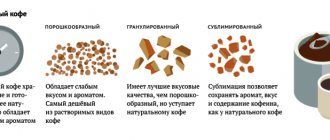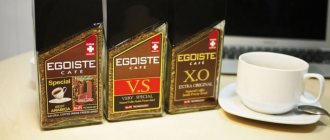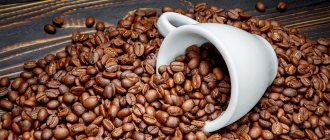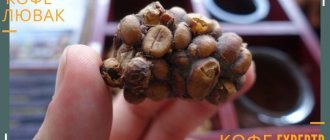Instant coffee is very popular today, as it is an instant product, but not many people know how freeze-dried coffee is made and how it differs from instant powder. The production of freeze-dried coffee began with the fact that technology developers tried to achieve the same wonderful taste and aroma from instant coffee as natural coffee. Let's see what they did for this.
History of freeze-dried coffee
Even in a regular freezer, food tends to dry out a little over time. The lower the pressure and temperature, the faster the drying process occurs, and in a vacuum, water evaporates almost instantly.
The technology of freeze drying (freezing, sublimation), developed in 1906 by the French biophysicist Jacques-Arsene d'Arsonval, is based on this natural property of water. The method was subsequently used to make vaccines. During World War II, the American scientific organization National Research Corporation (NRC) used freeze-drying technology to produce antibiotics and transport blood serum for the army.
After the war, NRC scientists turned to civilian projects. It turned out that when dry foods are frozen, they retain much more nutrients than when cooked. Experiments with freeze-drying coffee lasted more than 10 years, and only in 1965 the Nestle company released the world's first instant freeze-dried coffee, Nescafe Gold.
Consumers liked the drink so much that over the next 15 years, most well-known companies also began to produce instant coffee using the sublimation method. By the 1980s, up to 40% of instant coffee was produced using this method. The freezing technology is called freez dried.
Don Valencia, head of research and development at Starbooks, has spent over 20 years creating the perfect freeze-dried coffee, indistinguishable from the real thing. The scientist experimented not only with the temperature and time of freezing, but also selected varieties of coffee beans that were most suitable for making freeze-dried coffee, and used various roasting methods.
At the beginning of the 21st century, Mr. Valencia managed to obtain freeze-dried coffee called “Stardust.” It is now added to all Pepsi canned coffee drinks. After the scientist's death in 2007, Stardust was renamed in honor of its inventor, and is now called Via.
What is instant coffee made from?
You won't believe it - but exclusively from coffee. Despite all the rumors and myths regarding the “unnaturalness” of the instant drink, there is nothing in it except the same chemicals that are contained in classic coffee.
The basis is coffee beans that have undergone careful selection and quality control. This is not the most expensive raw material, but it meets all the requirements of food standards. During the extraction process, mainly caffeine molecules and trace elements pass into the concentrate, and essential oils evaporate (which is why instant coffee does not have the same taste and aroma as regular coffee).
Composition of instant coffee
Instant coffee contains:
- B vitamins,
- minerals (potassium, calcium, magnesium, phosphorus, sodium and selenium),
- carbohydrates (0.3 g per 100 g),
- antioxidants,
- caffeine.
The calorie content of instant coffee is approximately 1 kcal.
Instant coffee does NOT contain: preservatives, dyes, flavors, stabilizers.
Does instant coffee contain caffeine?
Of course there is! Otherwise, what would be the point of making this product? In its dry form, instant coffee contains approximately 1500–2000 mg of caffeine per 100 g. If you put 1 teaspoon of powder or granules in a cup (that is, 2 g), you get a drink with 30–40 mg of caffeine, 2 teaspoons will have more 60–80 mg of caffeine, which is roughly comparable to a serving of a standard grain Americano. The amount of caffeine per 100 g of product varies depending on the manufacturer.
However, instant decaf (decaffeinated coffee) also exists. According to international standards, it should contain no more than 0.03 mg of caffeine per 100 g of product.
Ground coffee in instant Nescafe “Gold”, 750 g -25%
745 rub. 993 rub.
Instant coffee Ambassador “Platinum”, 95 g 230 rub.
Instant coffee Ambassador “Platinum”, 190 g 370 rub.
Instant coffee 3 in 1 Nescafe “Classic Cappuccino”, 20 bags 297 rub.
Instant coffee 3 in 1 Jockey “Strong”, 10 bags 86 rub.
Ground coffee in instant Nescafe “Classic”, mixed, 1000 g 935 rub.
Jacobs instant coffee “Monarch”, 47.5 g 132 rub.
Instant coffee Jacobs “Monarch”, 38 g 83 rub.
Choose instant coffee on TEA.ru
Differences between freeze-dried coffee and powdered and granulated coffee
You often read that instant coffee is made from low-quality beans, which are sometimes even difficult to sell in their raw form. However, freeze-dried coffee, unlike granulated and powdered coffee, retains some of the aroma and taste of the original raw material. Therefore, to produce such coffee, higher quality beans are needed: ripened, calibrated, cleared of pulp in compliance with technology, and not emitting an unpleasant odor.
Why drink freeze-dried or natural coffee?
A cup of invigorating drink, drunk in the morning, saves you from annoying drowsiness.
- It also enhances intelligence, energy and performance, affecting brain activity.
- When caffeine enters the blood, heart rate increases, blood pressure rises, and blood circulation improves.
- The regular presence of coffee in the diet can serve as a prevention of asthma, Parkinson's disease, and heart attack.
- Appetite improves, stomach upsets are prevented, and digestion is normalized.
- Drinking coffee before training makes it more effective and promotes weight loss. At the same time, the body “burns” fat more actively.
- Positively affects sperm motility.
Freeze-dried coffee
How to make freeze-dried coffee
Making freeze-dried coffee begins with roasting the beans. Every company has its own secret. For example, the producers of Colombian coffee Buencafé are proud that they use only high-quality Arabica beans, and roast the beans very slowly, which eliminates the appearance of a burnt smell and taste in the finished product.
After roasting, the beans are ground, aromatic substances are extracted, and brewed to obtain coffee concentrate. But if for powdered and granulated coffee the concentrate is sprayed with a stream of hot air, then when producing freeze-dried coffee the concentrate is cooled to –6 °C, which makes it more viscous.
The semi-frozen liquid is placed on a conveyor belt and deep frozen to a temperature of –40 to –50 °C. The faster the freezing, the lighter the freeze-dried coffee granules will be. The ice is then crushed and sifted. Large pieces of ice are sent to a vacuum cryochamber, small pieces are sent for re-freezing. In a vacuum cryochamber, water evaporates. The size of the granules depends on the size of the ice floes. If you dry too small pieces of ice, you will get a powder, which is unacceptable according to the standard.
Coffee concentrate contains aromatic substances (although much less of them than in natural beans). When dried hot, they completely evaporate, but when frozen, they are preserved. That’s why manufacturers indicate on the packaging: “natural freeze-dried coffee.” However, the granules are usually additionally flavored.
Freeze-dried coffee granules are harder than those obtained by hot drying granules. Frozen coffee dissolves slightly more slowly in water.
Benefit
When manufacturers speak about freeze-dried coffee, they claim that it is very healthy and does almost no harm to the body. What do the facts say?
- Freeze-dried coffee contains nicotinic acid, which is vital for vascular health.
- Antioxidants are also found in this product, although in much smaller quantities than in natural coffee.
- Any type of coffee significantly reduces the risk of developing many diseases. How this happens is still difficult to say with certainty. At least, numerous studies indicate such a preventive effect of coffee. Moreover, a positive effect was observed even in decaffeinated coffee, so it does not play the key role.
It's funny, but some people still try to tarnish the reputation of coffee, claiming that it is bad for the stomach, causing it to produce juice, but this is only harmful if consumed on an empty stomach. Or you can hear about increased load on the liver, but it is important to understand that significant problems only occur with abuse.
How to choose freeze-dried coffee
Freeze-dried coffee is most often sold in transparent cans; you can choose a quality product based on appearance and label:
- there should be no powder at the bottom of the jar;
- Responsible producers indicate on the label what varieties the freeze-dried coffee is made from: 100% Arabica or a mixture of Arabica and Robusta. It is believed that 100% Arabica coffee is better, but this is a matter of taste;
- Preference should be given to coffee with natural flavors;
- The color of the granules only indicates the speed of freezing. When quickly frozen, the granules become lighter in color.
Important! If the drink has a burnt cork taste, it means that the roasting technology was violated during the production of freeze-dried coffee, or low-grade, poorly calibrated beans were used. It is better not to buy products from this brand. A musty smell is also unacceptable (appears when the technology for extracting aromatic substances from ground grains is violated).
Definitions
Freeze-dried coffee is an instant drink produced using “dry freezing” technology. To make it, the beans are roasted and finely ground, then the resulting coffee “dust” is boiled in closed, sealed containers for about three hours. Steam is removed from the tanks using special pipes. Along with it, the essential oils contained in the grains also leave, which are subsequently extracted using special technologies. The digested coffee mass is subjected to rapid freezing in a vacuum, during which all moisture is removed from it. The dry product is broken into particles and soaked in essential oils extracted from the grains. Thanks to such a complex and delicate preparation technology, freeze-dried (or frozen) coffee is characterized by a rich taste and aroma. In the line of instant drinks in this category, it is considered the highest quality and natural.
Freeze-dried coffee
Granulated coffee is a soluble powder compressed into grains by steam treatment. The method of preparing the drink is called “spray-drying”. First, the grains undergo a cleaning procedure, after which they are fried and crushed into particles measuring 1.5-2 mm. The next step is the extraction of soluble substances. To do this, ground coffee is treated with hot water supplied under pressure for 3-4 hours. The resulting mass is cooled and filtered, insoluble and resinous substances are removed from it. The hot air-dried powder turns into lumps under the influence of steam. The use of this production technology leads to the fact that the resulting product almost does not retain the properties of natural coffee. Since during prolonged heat treatment of raw materials it practically loses its rich color and smell, various dyes and artificial flavors are added to the powder.
Granulated coffee
Famous brands of freeze-dried coffee
Starbucks Via Instant – there are several types on sale with varying degrees of roasting. The drink tastes like coffee brewed in a French press;
Bushido is a Japanese dark roasted freeze-dried coffee. The aroma is intense, close to natural, the taste is with a pleasant bitterness. Coffee dissolves only in hot water;
Carte Noire is a premium French coffee, there are several types on sale. The granules dissolve in cold water;
Tchibo Exclusive - coffee with a pleasant taste and aroma, belongs to the economy segment;
Nescafe is an inexpensive and very popular coffee. The drink smells nice, but the taste is inexpressive.
Granulated coffee
The production of coffee granules is easier, so its price tag is lower. The initial technological stage is no different from the process of manufacturing sublimated granules. The grains also go through the process of roasting, crushing and undergoing prolonged cooking.
The concentrated liquid is then sprayed into a thin layer and dried under high pressure at 250°C. The resulting mass is wetted with water, as a result of which it is transformed into loose granules with uneven edges. The product is not subjected to further processing; it is immediately packaged. The manufacturer does not enrich the granules with substances that were lost during the digestion process. This significantly reduces their cost.
How to brew freeze-dried coffee correctly
Ingredients:
- 1–2 tsp. freeze-dried coffee;
- 1–2 tsp. Sahara;
- 100–150 ml of water.
Recipe
Coffee and sugar are poured into a preheated cup, a teaspoon of water is added and thoroughly rubbed to form foam. Then add the rest of the water. It should not be hotter than +90 °C. To heat water, it is boiled until air bubbles appear. You should turn off the kettle and wait 2-3 minutes until the water cools down a little.
The more intensively you beat the coffee with sugar, the more fluffy the foam will be (although whipping freeze-dried coffee is harder than powdered coffee). If you are preparing several servings of the drink, it is convenient to use a mixer for whipping. You can decorate muffins with this foam. Sometimes it is laid on top of natural coffee brewed in a French press or Chemex.
In appearance, freeze-dried coffee cannot be distinguished from coffee brewed by other methods.
Freeze-dried coffee makes delicious milk-coffee cocktails.
Manufacturers, brands and prices
Below are popular brands and brands whose products can be found on the shelves of our stores.
- Nescafe. The leader in this segment has been producing instant coffee for a very long time. The average price is 250 rubles per 100 grams.
- Jacobs. A well-known brand with a wide range of coffee products. Instant is presented in several positions, at a price of 300 rubles per 100 grams.
- Bushido. A Japanese company that produces a premium product. The price is extremely high - 500 rubles per 100 grams. Our review is Bushido coffee.
- Carte Noire. Popular brand. Russian consumers highly value the quality of these products. See more details - coffee carte noir.
